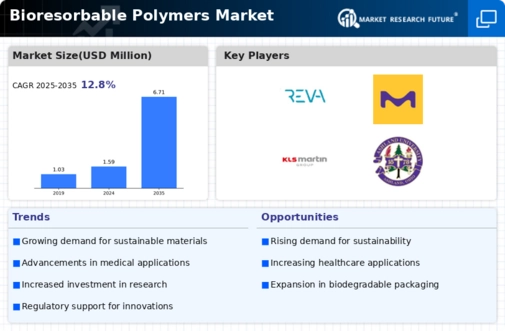Market Share
Bioresorbable Polymers Market Share Analysis
Revolutionizing Implants: The Role of Bioresorbable Polymers in Orthopedics and Dentistry
Orthopedic and dental implants have undergone a paradigm shift with the incorporation of bioresorbable polymers, also known as bioabsorbable polymers. These synthetic materials find utility in implanted medical devices, particularly in orthopedic and dental treatments, gradually dissolving over time when the scaffolding is no longer necessary. Polymeric biomaterials, a category to which bioresorbable polymers belong, are harnessed to stimulate tissue regeneration and replace damaged tissue, heralding a new era in implant technology.
Among the diverse array of bioresorbable polymers, hydroxy acids take the spotlight, with poly(glycolic acid) and polycaprolactone leading the pack. Various forms of poly(lactic acid), including poly(L-lactic acid), poly(D-lactic acid), and poly(DL-lactic acid), have also become stalwarts in the healthcare and medical industries. These polymers gain widespread acclaim for their exceptional biocompatibility, given that their breakdown products are naturally eliminated from the body through metabolic processes.
Polyglycolic acid (PGA) stands out as a bioresorbable polymer with immense potential in biomedical applications, poised to replace traditional biopolymers. Its versatility extends to biodegradable implants, where it can gradually degrade, transferring the load to the healing bone. PGA not only excels in biocompatibility and biodegradability but also boasts high strength and stiffness, rendering it suitable for a spectrum of short- and long-term implantable applications. As the healthcare sector experiences exponential growth, the demand for PGA is anticipated to surge, propelling the global market into a phase of substantial expansion during the forecast period.
The pivotal role played by PGA in biomedical applications extends to its ability to replace conventional biopolymers, positioning it as a preferred choice in the evolving landscape of implant technology. The intrinsic qualities of PGA, including biocompatibility, biodegradability, and mechanical strength, align seamlessly with the evolving requirements of orthopedic and dental treatments.
In essence, the integration of bioresorbable polymers like PGA marks a transformative chapter in the development of orthopedic and dental implants. The forecasted growth of the global market during the coming years is intricately tied to the expanding horizons of the healthcare sector and the escalating demand for innovative, biocompatible materials that ensure optimal patient outcomes. As orthopedic and dental treatments continue to advance, the indispensability of bioresorbable polymers in implant technology is poised to play a pivotal role in shaping the future of patient care.







Leave a Comment